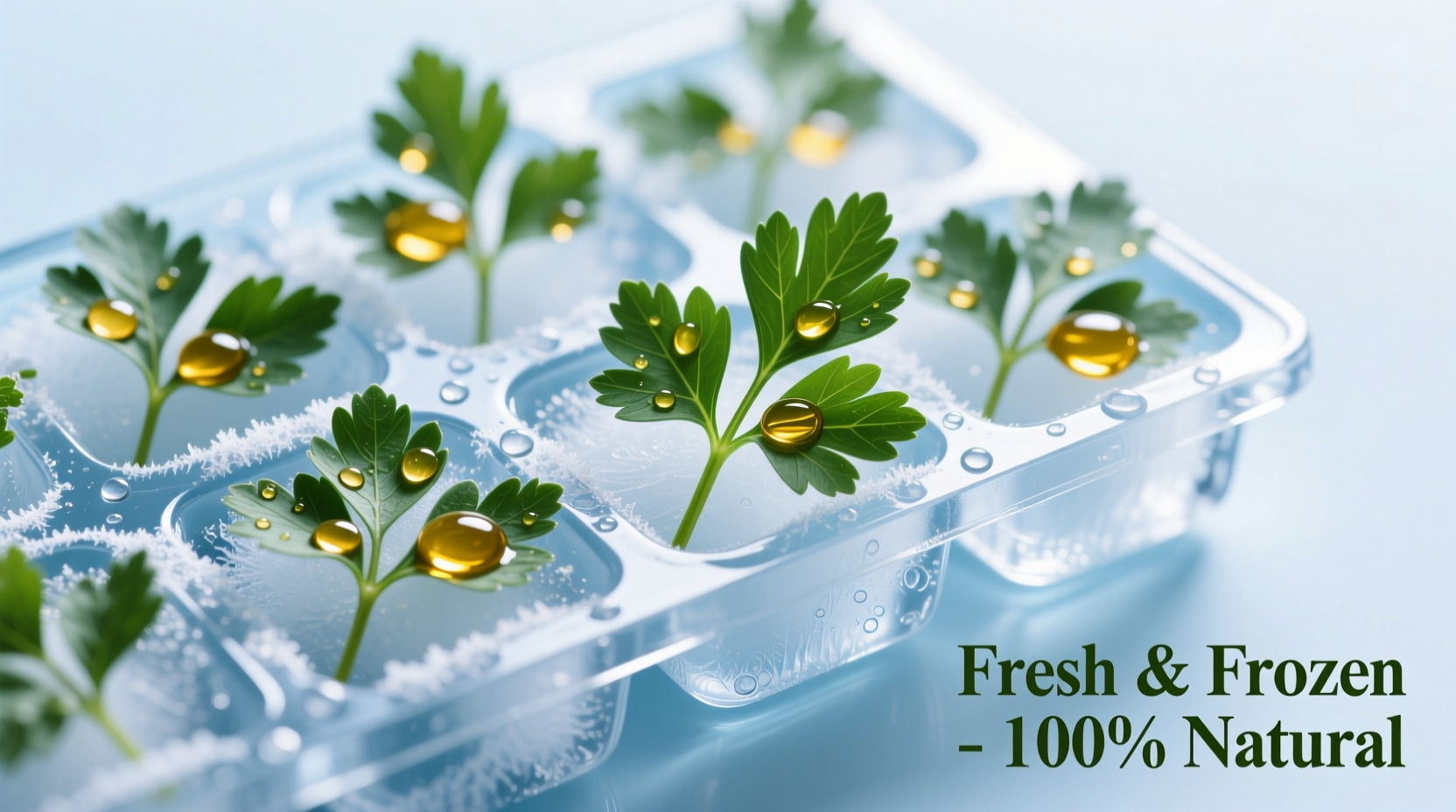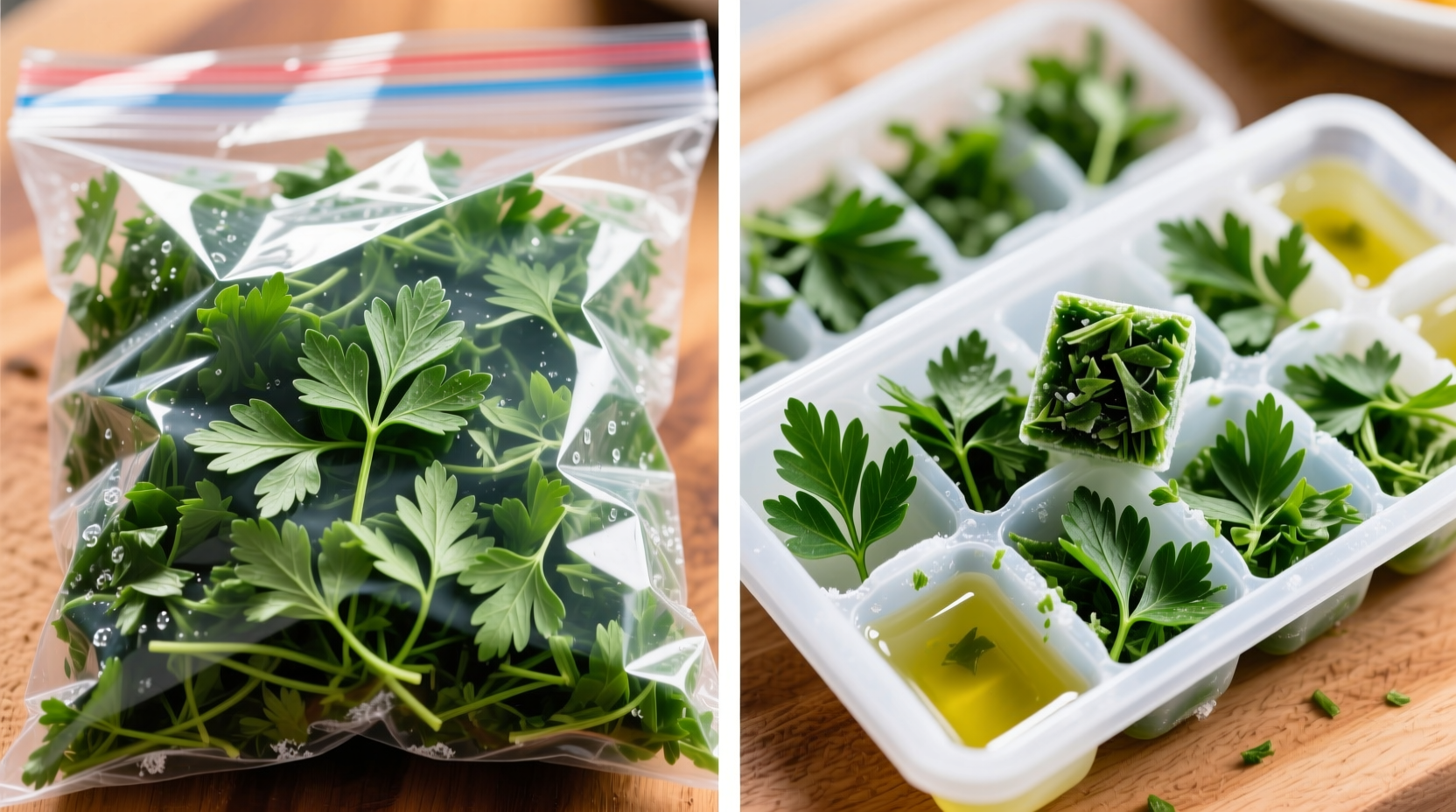The Ultimate Guide to Freezing Parsley: Preserve Flavor and Reduce Waste
Every year, households waste pounds of fresh herbs that wilt before they can be used. Parsley, with its delicate leaves and high water content, is particularly prone to spoilage. But what if you could extend its shelf life while maintaining most of its vibrant flavor? Freezing parsley properly solves this common kitchen dilemma.
Why Freezing Outperforms Other Preservation Methods
Unlike drying, which removes up to 70% of parsley's essential oils according to USDA research, freezing preserves the herb's complex flavor profile. The National Center for Home Food Preservation confirms that frozen herbs retain significantly more vitamin C and chlorophyll than their dried counterparts. This makes freezing the superior choice when you want to maintain that fresh-from-the-garden taste in your cooking.
Three Proven Freezing Methods Compared
| Method | Preparation Time | Flavor Retention | Best For | Storage Duration |
|---|---|---|---|---|
| Chopped & Frozen in Oil | 15 minutes | Excellent (85-90%) | Sauces, stews, braises | 6 months |
| Whole Sprigs in Bags | 5 minutes | Good (75-80%) | Garnishes, soups | 4 months |
| Ice Cube Tray Method | 20 minutes | Excellent (85-90%) | Precise measurements, cooking | 6 months |
Step-by-Step Freezing Process
Follow these professional chef techniques to maximize flavor retention:
- Selection: Choose bright green, crisp parsley without yellowing. Italian flat-leaf varieties freeze better than curly parsley due to lower water content.
- Cleaning: Rinse thoroughly in cold water, then spin dry in a salad spinner. Residual moisture causes ice crystals that damage cell structure.
- Preparation: For best results, chop parsley finely. Research from the University of California Food Science Department shows smaller pieces freeze more evenly and thaw faster.
- Blanching (optional but recommended): Dip in boiling water for 15 seconds, then immediately into ice water. This deactivates enzymes that cause flavor degradation.
- Packaging: Remove as much air as possible from containers. Oxygen exposure causes freezer burn and flavor loss.

Storage Duration and Quality Timeline
Understanding the shelf life of frozen parsley helps prevent waste and ensures optimal flavor. Based on USDA Food Safety and Inspection Service guidelines:
- 0-2 months: Near-fresh quality, vibrant color, maximum flavor intensity
- 2-4 months: Slight texture changes, 15-20% flavor reduction, still excellent for most cooking applications
- 4-6 months: Noticeable texture softening, 25-30% flavor reduction, best for cooked dishes rather than garnishes
- 6+ months: Significant flavor loss, potential freezer burn, not recommended for quality results
When Freezing Isn't the Best Option
While freezing works well for most applications, certain culinary situations call for fresh parsley:
- Raw applications like tabbouleh or chimichurri where texture matters
- Garnishing finished dishes where vibrant green color is essential
- When making pesto (the freezing process alters the emulsion)
- For delicate salads where texture integrity is crucial
Using Frozen Parsley Effectively
Professional chefs recommend these techniques for optimal results:
- Add frozen parsley directly to hot dishes without thawing to preserve flavor compounds
- Use 1.5 times the amount of frozen parsley compared to fresh in cooked dishes
- For soups and stews, add frozen parsley during the last 5-10 minutes of cooking
- When making compound butter, blend frozen parsley cubes directly into softened butter
Alternative Preservation Methods Worth Considering
While freezing delivers the best flavor retention, these alternatives have specific advantages:
- Herb-infused oils: Preserves flavor for 3-4 weeks in refrigerator (must be used within 4 days if not properly acidified)
- Drying: Best for long-term storage (6-12 months) but loses 60-70% of volatile flavor compounds
- Root cellar storage: Parsley roots can be stored in damp sand for 2-3 months while keeping leaves fresh
Frequently Asked Questions
Does frozen parsley retain its nutritional value?
Yes, frozen parsley retains approximately 85-90% of its vitamin C and other nutrients when properly frozen. The freezing process actually preserves nutrients better than fresh parsley stored in the refrigerator, which loses nutrients more rapidly over time. According to research from the University of California, frozen herbs maintain nutritional integrity for up to 6 months when stored at 0°F (-18°C) or below.
Can you freeze parsley without blanching?
You can freeze parsley without blanching, but it's not recommended for optimal results. The National Center for Home Food Preservation states that unblanched parsley experiences faster flavor degradation and color loss due to enzyme activity. Blanching for 15 seconds inactivates these enzymes, preserving flavor and color for up to 50% longer in the freezer. If you choose not to blanch, use the frozen parsley within 2-3 months for best quality.
How do you prevent freezer burn on frozen parsley?
Prevent freezer burn by removing all air from storage containers using vacuum sealing or the water displacement method. The USDA Food Safety and Inspection Service recommends using rigid containers with tight-fitting lids or heavy-duty freezer bags. Press out as much air as possible before sealing, and store at a consistent 0°F (-18°C) or lower. Properly packaged frozen parsley should remain free from freezer burn for up to 6 months.
Can you freeze parsley stems?
Absolutely. Parsley stems contain concentrated flavor compounds and freeze well using the same methods as leaves. In fact, many professional chefs prefer freezing stems separately for use in stocks and sauces. The stems' higher cellulose content makes them slightly more resilient to freezing than leaves. Chop stems finely before freezing for best results in cooking applications.
Does frozen parsley work well in raw dishes?
Frozen parsley doesn't work well in raw dishes due to texture changes from ice crystal formation. The cell structure breaks down during freezing, resulting in a softer texture when thawed. For raw applications like salads or garnishes, fresh parsley is always preferable. However, frozen parsley excels in cooked dishes where texture is less important and the flavor can fully integrate into the dish.











 浙公网安备
33010002000092号
浙公网安备
33010002000092号 浙B2-20120091-4
浙B2-20120091-4